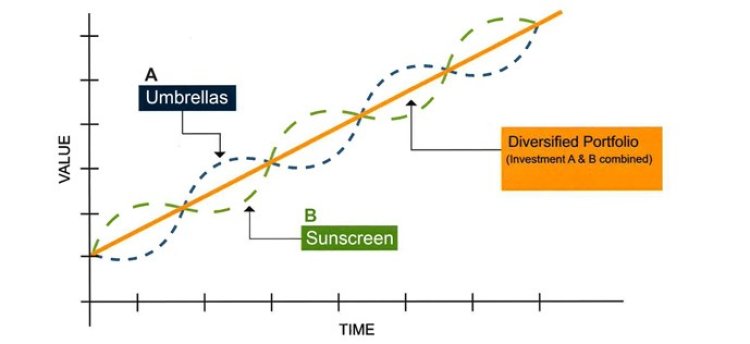The meaning of “portfolio diversification” and methods for creating one are discussed. The whole point of diversity is to cut down on potential losses. When the cycle swings downward, if all your assets are headed in the same direction, you may expect a loss across the board. In the event of a global downturn in the metal cycle, for instance, a portfolio that is heavily weighted toward metal equities stands to lose the most. Diversifying your portfolio with investments that aren’t perfectly correlated will help you sleep easier at night. Let’s look at a simplified example of portfolio diversification using just two assets that are uncorrelated with one another. As a result, if the returns on one asset go up, the returns on the other asset will go down. You can sketch the correlation between diversification and..

When returns on Asset Class A are high, those on Asset Class B are low, and visa versa. Over time, this causes returns on average to rise. That’s what we call the “umbrella asset” + “sunscreen asset” combination. This advantage occurs as a result of merging portfolios A and B.
Why do people diversify if it doesn’t make sense?
Two distinct forms of risk allow for effective diversification. Unique assets, industries, or topics provide the unsystematic risk. By pooling together assets with either negative or low correlations, this can be lowered to almost nothing. These include things like the possibility of a rise in interest rates or bond yields, the possibility of labor unrest in some sectors, the possibility of a downturn in the commodity cycle, and so on. However, systemic risk affects every type of investment. All investments should be avoided during times of political unpredictability, slowing GDP growth, or increased global geopolitical risk.

The above graph allows us to make three important inferences. To begin, diversification can only be used for unsystematic risk. Diversifying across asset classes does not protect you from systematic risk. Second, even if you successfully diversify your portfolio, you will still be exposed to some degree of unsystematic risk. Unsystematic danger can only be mitigated to a great extent. Finally, increasing the number of assets can only help so much. Beyond that point, all that happens is a replacement of risks, therefore the level of unsystematic risk is also constant.
How to go about the process of diversification..
To reduce your exposure to financial uncertainty, please follow this rational procedure.
Diversify among asset classes
Investing in multiple different types of assets is the first step. This is why a diversified portfolio including stocks, bonds, ETFs, index funds, gold, real estate, overseas assets, etc. is essential. This lowers the risk of your portfolio as a whole by distributing it across a wider variety of investments. The first step in diversifying your portfolio is to decide which asset categories you’d like it to hold.
Diversify within debt based on quality
Next, you should diversify within debt on the basis of asset quality once you have established debt as an asset class and mapped out the total exposure to debt. Investing in risk-free government assets and state government securities both have their benefits and drawbacks. The next level up is corporate debt. You must make a decision as to the appropriate allocation of capital between AAA-rated corporate debt and AA-rated corporate debt. Avoid going below AA if at all possible, as doing so carries a larger default risk along with better rewards.
Diversify within debt based on duration
What do we mean when we talk about duration-based debt diversification? Your liquidity requirements are the key to understanding. Therefore, you should have a mix of both liquid and debt funds in your portfolio. How proportion of a debt fund’s holdings should be longer- and shorter-term investments? That depends on your interest rate forecast. Your choice of diversification mix should be based on the expected negative reaction of long maturity bonds to rising bond yields.
Diversify within equity by Sectors
Capital goods, consumer products, pharmaceuticals, the information technology industry, etc. are all examples of sectors. Each of these fields need its own special characteristics. When the building industry picks up, some materials, like cement and steel, benefit. When interest rates fall, it helps the banking sector and the equities of financial institutions. When the commodity cycle rises, industries like oil and steel profit. Investing wisely in a spread of these markets can help spread your risk.
Diversify within equity by themes
What makes themes distinct from industries? In reality, though, themes can extend to many other fields. Let’s take rate sensitivity as an example. Declining interest rates are good for industries like banking, NBFCs, autos, and real estate. It is important to avoid excessive exposure to any single theme when diversifying by theme. Tractors, motorcycles, fast food, consumer packaged goods, fertilizer, hybrid seeds, and other agricultural inputs all benefit from increased rural earnings. Your strategy for diversification must take this into account.
Diversify by companies
Finally, diversification within firms along a number of different themes is essential. Consider a few examples. Businesses with strong operating margins and asset turnover rates should be merged. Similarly, you should diversify your portfolio by holding both high growth stocks and dividend-paying firms. This synergy will guarantee a beneficial final result.
One of the cornerstones of investment is diversification, one of the simplest and most fundamental ways to mitigate loss. That’s the first step in making a portfolio.
Read Also : TOP 10 FINANCIAL MAGAZINES IN INDIA IN 2023




